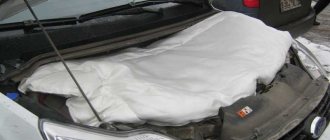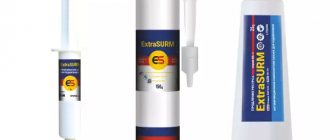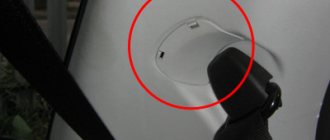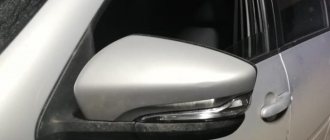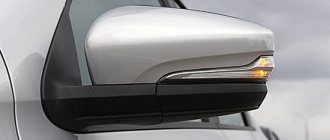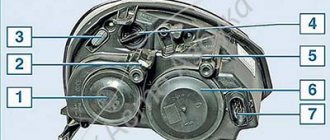Russian winters are always famous for long and severe frosts, which is why every driver is faced with the task of thermal insulation of his vehicle. This work is not difficult; with proper organization, you can do it yourself, without the help of specialists.
Insulate your car!
Noise-vibration-thermal insulation will require very little money and free time, and you yourself, with your own hands, will be able to insulate your vehicle. We will be happy to help you with this necessary event.
What and how to insulate the engine
To insulate the engine, as a rule, special sheets of foam rubber or polyethylene covered with a layer of foil are used. The main thing is that such materials also have sound insulation and are also fireproof. It is best, according to experts, to insulate the engine with penofol.
Do-it-yourself procedure for thermal insulation of an engine
- Remove the pattern from the inside of the hood. It is convenient to do this using tracing paper.
- We transfer the pattern to the material. Carefully cut out the parts with a stationery knife.
- Using moisture-resistant glue, we attach the thermal insulation to the inside of the hood, while the foil should remain outside.
You need to attach the insulation especially carefully so that it does not come off when driving, otherwise this will lead to unpleasant consequences for the engine and for you. Again, you need to manage to do this so that in the spring you can remove the insulation without damaging the hood.
Important. Automotive thermal insulation should not come into contact with the exhaust manifold and exhaust parts.
That's the whole trick! The costs for materials are minimal, but what is the result? The car warms up faster because heat does not escape through the hood. The engine remains warm for a long time, which means starting the car will be faster and easier. At the same time, car oil will not become viscous from the cold, and ice will no longer form on the hood, which can lead to metal corrosion.
The issue of car fuel economy is also being resolved. This also achieves the effect of engine noise insulation.
Recently, special car blankets for engine insulation have gone on sale. A very convenient thing. You just cover the engine in frosty weather, and when it gets warmer, remove it. It is only important to select this kind of thermal insulation according to the size of the engine compartment of your car. The main characteristics of a blanket for engine thermal insulation: fire resistance up to 800°C; fuel savings up to 30%.
In addition, insulate the car’s radiator grill with a so-called “muzzle.” It is very easy to sew using materials such as vinyl leatherette, batting or foam rubber. It is very easy to use. When they put it on coldly, it became warm, and they took it off.
How and how to insulate a car interior
It is very important to choose a material for thermal insulation that meets all the necessary requirements. It should be:
- non-toxic;
- with a heating temperature above 160°C;
- non-flammable;
- not labor-intensive to work with your own hands;
- steam and sound insulating;
- not thermally conductive;
- light, flexible, thin and at the same time durable;
- with reflective effect;
- certified by the sanitary and epidemiological station.
Such thermal insulation material exists. It's called penofol. This is polyethylene foamed with gas, covered with a layer of foil. This is what experts recommend to use for noise, vibration and heat insulation of the car interior.
In addition, you will need the following materials: rubber door seals, sealant, glue, stapler and staples for it.
Let's start working on insulating the interior with our own hands:
- We disconnect the panels from the car doors and take out the seats, this will make it more convenient to work. Remove the sheathing from the roof.
- We replace rubber seals on all existing doors.
- We remove patterns from those areas of the car that you are going to insulate (floor, roof, doors).
- We seal the cracks on the floor with sealant, then the thermal insulation will be more effective.
- Using a stationery knife, we cut out the parts from penofol according to the patterns.
- We lay and attach the floor parts with special glue, or using a stapler. Let them dry well. Make sure that the edges of the material do not extend beyond certain places. Everything should be clear and neat. Observe all dimensions exactly, this will further protect the movement of your car.
- Do-it-yourself thermal insulation of doors is done in the same way. We cover the inside parts of the doors with penofol and let them dry. We carefully cut out the spaces for speakers on the doors. We install the trim in place using special car clips. Don't forget to check the operation of the handles and window lifts.
- Let's move on to the thermal insulation of the roof and frames of the car. Carefully apply special glue to them and glue the foam foam pattern for the roofs. Leave to dry. then we attach the upholstery; if it is no longer suitable for further use, it is easier to cut out a new one with your own hands.
Insulating the trunk of a car
Car trunk insulation
To insulate the trunk, they use both penofol and other insulation materials (splen, isolon, vibroplast):
- We remove everything from the trunk. We clean it thoroughly. Remove the clips that held the upholstery.
- We remove the patterns from the bottom and wings of the trunk. We cut out parts from the selected material using our own hands.
- Using glue or a stapler, secure them inside the trunk of the car.
- We lay the trim on top (you can make it from vinyl artificial leather, it will be more practical) and fasten everything with car clips. You can make a rigid base, for example, from thick cardboard.
- At the rear door of the car, remove the upholstery and attach thermal insulation parts to the inside of the door. Using clips, install the upholstery in place.
Materials for car insulation
Modern professional insulation is very effective, easy to install, and, if necessary, quickly removed. You can insulate the car interior with your own hands using the following materials, which are well-known and in greatest demand:
- Isolon - a material with a good heat-insulating effect, is used to retain heat in the engine compartment;
- tiviplen-P – contains three layers: adhesive, polyethylene foam and outer layer. There is no foil in this insulation, but even without this component, it retains heat well;
- stizol and isotone - materials that give a double effect, retain heat well and provide reliable sound insulation;
- isoflex - used mainly as a sound-absorbing material, but also as insulation. It is in great demand among car enthusiasts due to its low cost;
- penofol is polyethylene foam with a layer of aluminum foil. Retains heat well and insulates noise, with a relatively small layer thickness. The most budget material for most car owners. Lightweight and flexible, with a long service life, easy to install, retains heat in the cabin for a long time, and keeps cool in the summer;
- polyurethane foam - applied by spraying, effective for clogging all existing holes and cracks, due to its low thermal conductivity coefficient even with a thin layer of application. It does not pose a respiratory hazard and has a reliable anti-corrosion effect. The main inconvenience is that professional equipment and specialists are required.
Engine insulation
First, let's think about why engine insulation may be needed.
Theory
We all understand that starting a power unit in cold weather is accompanied by significant loads on the rubbing parts. This is due to the fact that at very low temperatures (below -20 degrees Celsius) absolutely any motor oil becomes similar to liquid paraffin, and at even lower temperatures it becomes like solid paraffin. And expensive synthetic ones are no exception, by the way – I’ve seen them myself.
So, after the engine is stopped, the oil slowly flows into the crankcase. Only a thin film of oil remains on the car engine parts. This is how it should be, in fact. Now let’s imagine that the engine has cooled down to at least those -20 degrees. What happened to the oil film, do you think? That's right, it remained, only no longer in a liquid state, but in a solid state. And the oil in the crankcase is not liquid at all.
Accordingly, in winter, from the moment the engine starts until the temperature of the parts rises to the point where the oil becomes liquid, the parts will work without proper lubrication, and the oil pump will not be able to properly provide the power unit with lubrication - try pumping paraffin... Under such conditions, the friction force that occurs between engine parts increases significantly. And this is bad - parts wear out faster, therefore, the engine’s life is reduced faster than planned by its creators.
So where am I going with this? And besides, starting the engine in severe frosts is bad. That is why a reasonable question arises whether it is necessary to insulate the engine - well, so that it is not so difficult for it to start in cold weather.
Is it necessary to insulate the engine?
So is it worth insulating your car engine in winter or not? To give a final answer, you must additionally answer the following questions:
- Will insulation help reduce the load on moving parts of the power unit during a cold start?
- Are there such materials or ready-made solutions for engine insulation?
- Will the insulation create problems for the engine, i.e. Will the power unit operate in the correct mode?
- If you cover the engine, is there a risk of fire?
1.
Let's imagine that the car was parked on the street at night. Accordingly, the motor temperature corresponds to the ambient temperature. Even if the engine is insulated. Let's say it's -30 degrees. Consequently, our oil is in the wrong state of aggregation - instead of a liquid, we have a frozen substance. This means that a cold start of an insulated engine that has been standing all night in the cold will be no different from starting an uninsulated engine. If you look from this position, then insulation is completely unnecessary.
It’s another matter if during the day the car is used in the “drive, stay, drive” mode. In this case, to the question of whether it is necessary to insulate the engine, I think the majority (including myself) will answer positively. A properly insulated engine cools down, judging by reviews from car enthusiasts, about 20-30% longer. Therefore, if the car is actively used during the day, then insulation is definitely advisable.
2.
Currently, there are a lot of different manufacturers on the market that produce the same solution - the so-called “auto blanket”. Nothing new has yet been invented to preserve heat under the hood.
Our grandfathers and fathers tried to cover the engines with felt (at worst, a padded jacket or a battered mattress), and the car radiator was covered with ordinary cardboard from the oncoming air currents. By the way, you can still meet such individuals on our streets. Now – “new technologies”.
While looking for information about different types of insulation, I came across the position of some users that we need to carefully study the composition of the “car blanket” - after all, we will breathe the air that passes through it. You don’t want to get some kind of “sore” because you breathe in harmful substances. Even if the volume of air passing through the insulation is a small fraction of the volume that enters the cabin from the deflectors, I think this position is not without meaning. But this is true, by the way, for general development.
3.
Looking at the variety of options for the same product, you involuntarily ask yourself the question of how to cover a car engine in winter, what kind of insulation to prefer. After all, you need to cover the engine wisely, because there is a possibility of a violation of the cooling technology of the power unit.
How to insulate the engine compartment so that the covering material for insulation does not interfere with the proper operation of the engine? First of all, we are interested in the fact that due to the insulation, the engine will not be fully cooled. This can lead to overheating of the power unit. By the way, if the radiator is closed, then overheating cannot be avoided. Although, it all depends on the temperature outside. Of course, there is no point in thinking ahead, but still, this is a completely logical nuance.
Some people think that it is necessary to cover only the “face” - that is, it is enough to insulate the car’s radiator, but covering the engine is not necessary or undesirable (it is fraught with fires). Some people, on the contrary, don’t even think about whether it is necessary to insulate the engine (for him this issue has already been resolved), but are purposefully looking for a solution on how and how best to insulate the engine, believing that under no circumstances should the radiator be closed - cooling should not suffer.
In general, answering the question whether the cooling process of the power unit will be disrupted if the engine and engine compartment are insulated, I would like to admit that there is no clear answer to this question. It is necessary to experiment. It all depends on the car, the insulation used, insulation technology and climatic conditions.
4.
Very good question. And correct. Regardless of which method of engine insulation is chosen, the chances of a fire increase. And the manufacturer, by the way, will not bear any responsibility for what happened, because you, and only you, will be to blame. They themselves decided how to insulate the car engine for the winter, they themselves decided with what. Not a warranty case.
Previously, felt was considered the best material, because... unlike old padded jackets, mattresses, etc. it does not burn, but chars, or, at most, smolders. Therefore, the risk of fire with its use was minimized. Nowadays, there are more efficient materials that are not only non-flammable, but also resistant to fuels and lubricants, plus they are dielectrics (which means there is nothing to be afraid of a short circuit).
To insulate or not?
So is it worth insulating your car engine in winter or not? The question, as it turned out, is not an easy one. If the car is used infrequently, then the question disappears (it is not advisable to bother with several trips a week or a month), but if the car is used actively, not just daily, but several times a day, then my personal position is this: insulation is a must!
Again, it all depends on the climatic conditions of your region. If in winter your temperature rarely drops below 15-20 degrees, then I think the insulation is more of a “hemorrhoid” than a benefit. And if you are a “happy” resident of the North or equivalent territories of our vast Motherland, where frost -30 is not frost, then I think that the question of whether it is necessary to insulate the engine is not a question for you. Of course we should!
As for whether the insulation will interfere with the engine’s ability to cool properly, I think we have given a more or less clear answer: we need to experiment and use the experience of other motorists from regions with similar climatic conditions. As for the question of whether modern “car blankets” are fireproof or toxic – you just need to study the certificates before purchasing, that’s all.
How to insulate the engine?
If the issue with the need to insulate the engine compartment has been resolved, then a new question arises: how to insulate a car engine for the winter? There are two main options here:
- Purchasing or independently sewing a “car blanket” - a covering heat-insulating shield,
- insulation of the hood cover.
There is another, extreme one: insulating the lower part of the engine compartment. Why did I call it "extreme"? Yes, because I don’t have a very clear idea of what it should look like and what the service life of this “work of folk art” will be.
By the way, if you know how to insulate a diesel engine, then write in the comments, because personally I don’t understand how insulating a diesel engine differs from insulating a gasoline engine.
What can you cover the engine with?
So, here are two options for how to cover a car engine in winter so that it cools down longer and the chance of spontaneous combustion of the insulation is minimized:
- Felt. One of the most affordable materials for engine insulation. Cut to your size. Does not burn, char or smolder.
- Car blanket. Can be found for almost any car. Huge selection of manufacturers. The prices are higher than felt, but you get a finished product. There are uncertified insulation materials whose composition and characteristics cannot be verified. But most are absolutely non-flammable and are dielectrics.
How can you insulate the hood?
List of what to insulate the hood with:
- Izolon,
- folgoisolon,
- penofol,
- tiviplen,
- isoflex,
- stizol,
- polyethylene foam,
- splen,
- USG,
- foamed polyethylene.
All of the materials listed are foamed microporous sheets or rolls. They got their thermal insulation properties (as well as sound insulation, by the way) thanks to their porous structure and small air bubbles.
Some insulation also has options with a foil outer layer. The foil in this case works as a reflector of infrared rays coming from a hot motor. On the one hand, this is a plus - thermal insulation is more effective, and the engine cooling time increases. On the other hand, foil conducts electricity, which means that if it comes into contact with the battery terminals, a short circuit is possible. To avoid a fire, it is necessary to correctly calculate the thickness of the insulation glued to the inside of the hood lid so that it does not reach the battery.
How to insulate an engine with your own hands
I answer the question of those who are interested in how to insulate a car engine with their own hands. If you decide to do everything yourself, then the most affordable option would be this: insulate the hood cover from the inside with isolon, and cover the engine on top with felt. Both can be easily found in the market. This method of insulating the engine compartment is the most budget-friendly. As they say, cheap and cheerful.
The sequence of installing insulation in a car
First of all, choose the material with which you intend to insulate the interior of the car. To carry out the work you will need the following tools:
- sheet cardboard;
- scotch;
- marker;
- sealant;
- knife;
- rubber seals;
- screwdriver;
- scissors.
First you need to go to the car wash and do a complete cleaning of the interior. Then, preferably in the garage, remove all the seats, remove the door panels and disassemble the dashboard. All items on the rear shelf must be removed.
After inspecting the condition of the body, seal all holes with sealant. Pay special attention to the area between the engine compartment and the passenger compartment. Remove the heater core and seal all visible seams. Replace worn out old rubber seals with new ones.
It is necessary to start processing the interior for insulation from the floor of the body. Thoroughly clean the underbody of the car and treat it with solvent. Prepare patterns from cardboard sheets.
Buy the calculated volume of material in the store, plus a small supply. Using the cardboard patterns you made, cut out the penofol to the required size. If you have material without an adhesive layer, then you will also have to buy Tilit glue to connect the seams of the insulation.
We move on to the doors, we also carefully wash them and treat them with a solvent, then cut out holes for the handles. We glue the pieces of insulation in the same way as on the bottom. Clips are used in places with pronounced relief; we fasten them inside using furniture staples.
We reviewed general recommendations for insulating the car interior ourselves. In the next section we will look at laying insulation for various cars.
Preparing the car
Before carrying out insulation work, the interior should be disassembled. All the seats are pulled out of it. It is imperative to dismantle the trim, this also includes the headliner. On some models it is quite difficult to pull it out, but if you leave the roof without insulation, then all other work will be pointless. Be sure to wash your car. This will allow the material to be laid more evenly. In addition, you should pay attention to the doors. They are also insulated. To do this you will have to remove the casing from them too. When removing controls for mirrors and lifts, be careful not to break them.
After removing the casing, carefully inspect the body. All excess and unnecessary holes are sealed. Particular care should be taken to evaluate the transition points of the wiring from the passenger compartment to the engine compartment. Install new seals. This will prevent heat leakage.
Installation of thermal insulation on UAZ cars
In the UAZ-469, in winter, another heater is installed or the standard one is replaced with a device of increased power. It all depends on the finances and taste of the car owner; we recommend the heater used on minibuses of the KITB.3221-8110010 brand.
If your UAZ is equipped with equipment for running on gas, then a gas autonomous heater is perfect, but its power must be at least 2-4 kW. The electronics of this device automatically maintains the temperature regime inside the cabin, but a specialist must connect the device.
The additional heater is located at the rear at the very end of the cabin.
Insulate the bottom of the cabin with warm linoleum or a set from the store designed specifically for the UAZ floor, consisting of foil foam rubber. Cover the interior ceiling, sides, door panels and the area under the dashboard with the same insulation. UAZ Hunter seals are suitable for all door openings.
Install a warm polymer top instead of a canvas one, and seal all holes and cracks in the interior.
When installing heat protection on a UAZ-3909 or, simply put, on a “loaf”, you must try not to seal the standard ventilation system, making the interior a kind of thermos. If you accidentally block the factory ventilation, a large mass of condensation will form in the cabin.
Polyurethane foam, coupled with polystyrene foam covered with foil, prevents heat from escaping from the interior and lasts quite a long time, so this coating is fully justified. Another option is to sheathe the interior with 4 mm plywood or cover it with medium-thick foam rubber.
Why you need to insulate your car for the winter
Many drivers are interested in why they need to insulate their car. Experts believe that negative external factors, such as operation in any weather, increased load, poor-quality road surface, temperature changes, quickly render the car unusable. So, even a high-quality car begins to fail after 5 years of intensive use. This may be manifested by the passage of extraneous noise, sounds in the cabin along with the refreshing winter air.
If you point a thermal imager at such a car, which measures the temperature of surfaces using a non-contact method, you can see something unpleasant. We are talking about heat leakage zones, and the vehicle itself will be like a sieve. This unpleasant situation leads to the fact that when the engine is turned off, warm air will instantly evaporate from the cabin. And this will only take a couple of minutes.
The need to insulate a car is as follows:
- Engine idle time is reduced. To maintain a comfortable temperature inside the car in winter, you need to periodically start the engine. But if the vehicle has not been insulated, warm air will not even linger in the cabin, which in turn will force the driver to constantly start the engine. This consumes a lot of fuel and can lead to damage to working engine parts. In the case of a winter-ready interior, the heat will be retained for as long as possible, which will reduce engine starting to a minimum;
- Sound insulation is improved. Extraneous noise in the car distracts the driver from the road, which can lead to accidents;
- vibration is reduced. This will be especially useful for old domestically produced cars, which often rattle and squeak during operation;
- damage to the paintwork is prevented, since ice on the hood only leads to negative consequences;
- engine starting is improved in winter. By insulating the engine, the driver will be able to start the car without any problems after a night's rest, while the vehicle is in the fresh air. This is due to the fact that the space under the hood retains the heat that was generated when the engine was running for as long as possible, preventing the oil from thickening.
Thermal protection equipment for VAZ family cars
By insulating the inside of the car, we create conditions to reduce heat transfer from the body and maintain a constant temperature in the cabin. At the same time, it also has excellent sound insulation, which significantly reduces noise in the cabin. Having insulated it, we see how the car windows stop fogging up, and we feel more comfortable and safe.
Recommendations on how to properly install insulation on VAZ family cars:
- First of all, get rid of domestic rubber seals; the poor quality of their manufacture prevents heat retention and drafts circulate throughout the cabin. To do this, you need to identify leaks at the sink and insulate these places well, they are simply not airtight. Install a new set of seals;
- remove pads and carpets from the interior floor and install the selected insulation, preferably penofol. This three-millimeter material with foil retains heat well and provides good sound insulation;
- remove the ceiling covering, cut out the required pieces of foam foam and carefully glue it to the interior ceiling. Don’t forget to seal the niche and rear seat panel with insulation;
- on the doors, remove the trim and vapor barrier. From the insulation, prepare gaskets suitable for the configuration and secure them to the doors using tape. Do not forget to leave holes for handles and levers, reinstall the trim and check the free movement of the window lifters;
- disassemble the dashboard, dismantle the heater radiator and check all the seams on it, carefully seal them. This work will add an extra 5-6 degrees of heat to your cabin and in cold weather it will become more noticeable.
We insulate the interiors of other VAZ cars in a similar way. When driving a VAZ 2115, 2110 and Priora in winter, many passengers sitting in the back seat often pay attention to the flow of cold air in this part of the cabin. The fact is that in the rear door at the very bottom there are ventilation linings made of plastic. At speed, such ventilation significantly lowers the temperature inside the cabin.
To better insulate the interior, you need to significantly reduce the flow of cold air. To do this, we remove the plastic linings and exactly according to them, cut out the required size from the insulation with a small margin. We glue the material onto the front side of the lining with special glue. We coat the hole for the overlay with Movil and install the overlay covered with insulation in place. Now the cold no longer penetrates into the interior, and ventilation is maintained and prevents moisture and condensation from accumulating at the bottom of the door.
How to insulate car doors with your own hands
Good day!
I recently made the doors heavier and insulated, and now I’ve added soundproofing and additional interior insulation to the work done! I bought a set for the lazy :)
I’ve been bookmarking it for a long time and planning it before winter, but someone’s thread here reminded me of what I wanted recently. It was blowing somewhere under the driver's door in a strong snowstorm on the winter road and felt cold. Let's see this winter! In the village I never noticed that there was blowing somewhere even in the strongest storm winds.
I was very pleased with the rubber band on the fifth door! We attach it to a VAZ 2109 like this one in this thread, but then after winter it cannot be removed, if you remove it it will be torn.
Thanks to the arch extensions and these rubber bands, the rear doors are finally clean! Dirt from below does not fly under the rubber band!
The doors began to close simply cool, I just enjoy this sound! But some of them began to open a little tight, it is necessary to either adjust the hinges, or wait until the elastic bands shrink slightly, I even unrolled the electrical tape on the staples and glued them for softness.
The only thing I didn’t do was glue the rubber bands that covered the cracks in the fifth door along the opening, since I hadn’t covered the stacks with film yet.
Good luck to everyone on and off the roads!
PS
At the request of orelwolf70 and for questions from denisgla, I took detailed photos of all the rubber bands used in the Chinese set, and detailed gluing of the fifth door, I peeled the paper off the 3M adhesive tape and carefully threaded it under the hinges of the fifth and front doors so that it would not stick, I helped with a flat screwdriver in the other hand, as he reached the end, pressed it with his fingers into the place of gluing and other available tools from the well-known yellow Chinese set for disassembling plastic panels.
Yes, of course, I washed all the glued areas with detergent and degreased them twice, first with Triple Cologne, and secondly with Pure Alcohol!
Summer is ending... And as they say: “prepare your sleigh in summer.” So I decided to make the interior warmer in a simple way, and most importantly simple and accessible to everyone. I bought regular foil-coated isolon. Because it’s inexpensive and most importantly effective! Description from the Internet:
— “Zero water absorption (water absorption), ... reduces the sound permeability of buildings, and also provides excellent vapor and heat insulation. This type of thermal insulation is also used to create a tight seal for cars and insulate production equipment..., a metallized film (lavsan), which covers the thermal insulation in the same way as insulation with foil, creates the effect of a “thermos”, but unlike foil thermal insulation does not create a corrosive layer, i.e. .e. it can be used as a thermal insulation layer..., it is characterized by high strength, reliability and long service life. Characterized by its light weight and thickness, it does not weigh down structures... and requires minimal installation costs. Soft and elastic, this insulation is easy to cut, bend, glue and nail…”.
I used 5 mm thick isolon. In general, everything is simple and clear. I cut it to the shape of the door and sealed it with reinforced tape. I also mapped the doors from the inside. Those. It turned out two layers of 5mm. I didn’t take many photos, I think everything is clear. In general, the doors began to close somehow more pleasantly, a little more quietly. Well, some noise insulation when driving is also noticeable.
Car insulation - ceiling, floor, luggage compartment, engine compartment. Effective adhesive-based reflective insulation. MORE.
How to insulate a car
In Siberia, with frost comes the desire to insulate your car. In fact, you can do it yourself and with a small investment.
How to insulate
The material used for this is known to everyone - foamed polyethylene with a reflective layer . The closed, finely porous structure does not allow heat, vapor, or sound waves to pass through, and the reflective layer works like a mirror in a thermos, reflecting heat and preventing it from entering the material.
· when insulating walls
· when insulating ceilings and roofs
· very common as a substrate for heated floors.
Its only difference is that it has an adhesive layer applied to it for ease of installation.
Selection of thickness
The greater the thickness, the longer the machine will cool down and heat up faster. The insulated space is usually limited, so 10mm thickness cannot be used everywhere. Recommended thicknesses – 5mm/8mm/10mm.
The physics of the process is as follows - the heat from the stove tends to warm up the entire space of the cabin, including objects. Objects: trim, rugs, seats - have the temperature of the metal with which they come into contact. The heat of the stove gradually tends to warm everything up, but since the interior is in contact with the body, the body cools all interior items, heat transfer is direct and very fast, there are no obstacles in the way of heat and it safely goes into the body, frame, etc., and frost does its job and safely cools the incoming heat. Thus, if the stove is weak, then it cannot cope with the very low temperature outside, so it is cold inside the car.
Even a small layer of thermal insulation will stop this transfer of cold into the cabin, and will become a barrier between cold and heat.
What can you do to insulate your car?
Ceiling
The largest areas that “cool out” the car are the floor and ceiling. It is easiest to insulate the ceiling and this is the most important, because... heat tends to rise! Install self-adhesive insulation on the ceiling of the car and the interior will become warmer much faster.
The floor is the most correct thing - dismantling the interior and installing insulation along the entire bottom, with the reflective layer up, returning the floor covering in place, on top of the insulation, and installing the seats. We get a barrier between the frozen floor and the interior. The floor covering and seats will heat up quickly and will not “pull the cold” from the floor. Such insulation will also significantly insulate your car.
If it is not possible to open the floor, then you can quickly lay even non-adhesive reflective insulation, just under the rugs - this will also significantly reduce the penetration of cold into the interior.
Doors
They are insulated by removing the trim and installing self-adhesive insulation inside the door on the outside of the door itself (the insulation is directed with a reflective layer into the interior). You can also stick insulation on the inside of the door, under the casing itself, here you need to take into account the fastening of the casing (large thickness may interfere with the installation of the casing)!
Thermal insulation equipment for foreign cars
Budget foreign cars are popular in Russia, they differ only in better sealing and good stoves. In fact, there is no insulation as such in foreign-made cars.
It is imperative to insulate the interior of foreign cars in our cold weather. If the thermal insulation of the engine can be solved with the help of a car blanket, then the body needs to be worked on. The best insulation material is penofol with its adhesive base and foil.
We remove the decorative door trim, cut out the insulation to the required size, leave holes so as not to interfere with the moving parts inside the door, and glue the foil part outward. Everything is simpler with the trunk; by the way, there are even places for fastening insulation. Usually this treatment is sufficient.
If your region has a more severe climate, you can cover the floor with insulation and cover the ceiling of the cabin with it.
Foreign cars can be equipped with thermal protection made of vibroplast - this material not only dampens vibration, but is also a good insulator in itself. We lay them on the floor, ceiling, all doors and trunk.
To keep the engine warm, we use a car blanket, although some manufacturers offer a plastic plate to cover the radiator, but this is clearly not enough.
In conclusion, it must be said that the more carefully and thoroughly you treat the interior of your car, the more comfortable and safe you will feel on the road.
Hello, dear guests and regular readers of the Avtogid.ru . Today in this article you can learn how to insulate your car for the winter with your own hands without outside help. The coming winter and the upcoming frosts are preparing a real test for any driver, regardless of his driving experience. It is important to meet them fully prepared and provide the most comfortable conditions for using the car in winter.
Many drivers doubt whether the game is worth the candle and whether it is necessary to insulate the car for the winter? Some of them believe that the costs of insulation are empty and will not bring any effect. In fact, they are deeply mistaken and for comparison they should use the car before and after insulation. The difference is simply huge and it is simply impossible not to notice it.
Insulating a car in winter allows the driver to kill two birds with one stone. Minimize heat loss from the car interior when the engine is turned off and increase the sound insulation of the cabin. All this together will significantly increase the level of comfort when using the vehicle.
Summing up
Insulating your car for the winter is not an easy task. Its solution is always hampered by both doubts about the feasibility of insulating the engine and budget limitations in most cases. I can only say this for sure: if you live in harsh climatic conditions and actively use your car, then you definitely need to insulate it. In terms of comfort, an insulated car cannot be compared with a “naked” phaeton. By insulating you will not only protect your health, but also your vehicle. I tried to answer the question of how to insulate a car with my own hands in this article. Please do not judge strictly if I forgot to mention something. Thank you for your attention!
See also:
- How to wash a car in winter in questions and answers
- Is it necessary to warm up the car engine in winter?
- Should I warm up my diesel engine in winter or not?
- How long does it take to warm up an automatic car in winter?
- Is it necessary to insulate the battery in a car in winter?
- Why turn on the air conditioning in your car in winter?
- Do-it-yourself insulation of a car radiator
- How much gasoline does it take to warm up a car in winter?
The procedure for insulating a car interior with your own hands
If you don’t want to waste your free time, are just lazy or have extra money, you can entrust the insulation of the car interior to specialists. In fact, the work is not labor-intensive and, in principle, any car enthusiast can do it if desired. The most important thing is to prepare and be patient. If you are bored working alone, you can take a partner. Get it faster and more fun.
The procedure for insulating a car interior with your own hands is as follows:
Preparatory stage.
The main task at this stage is to determine the material for insulating the interior. Experts or experienced drivers recommend using soundproofing materials and thereby killing two birds with one stone. As practice shows, Vibroplast and Izolon have proven themselves to be excellent. They are convenient to use and do not require much time to paste the material.
Be sure to have on hand: stationery scissors, hair dryer, rags, gloves, set of tools. If the insulation material has been purchased, you can proceed to the next stage.
Insulation of the car interior.
All work on insulating the car interior must be carried out in a garage with sufficient lighting. The quality of street work leaves much to be desired. The outside of the car must be washed before starting work. It is enough to vacuum the inside and simply wipe off the dust.
After general cleaning and washing, you need to wait until the body and interior of the car are completely dry. Car seats, headliners and interior doors are dismantled. You must act carefully so as not to break the fasteners.
The insulation is carefully cut to fit the dimensions of each element in the cabin. It is glued to the working surface of doors, ceilings and floors. It is smoothed out and to consolidate the effect, you need to walk over its surface with a hairdryer. This will ensure reliable fixation and durability of the insulation.
Insulation of the engine compartment.
To insulate the motor, a special heat-resistant material is used. It helps prevent the formation of an ice crust on the surface of the hood and significantly accelerates the warming up of the engine in winter.
The material is attached to the back of the hood and secured using special fasteners. To make it easier to start the engine, you can additionally insulate the battery. You can use the same material used for a car hood.
Completion of work.
After completing the work on insulating the car interior with your own hands, you need to install everything in place and securely fix it. There is no need to rush, as there is a high risk of damage to fasteners, especially in used cars.
At this point, the work on insulating the car interior can be considered completed.
Material selection
How to insulate a car interior with your own hands? This is quite a complex job that will require a large number of different actions from you. Difficulties begin from the moment of selecting heat-insulating material. It should hold heat well and not emit any harmful substances. Still, you will spend a lot of time in the salon.
The following materials are most often used for work:
- Penofol
. This is the cheapest insulation. It retains heat perfectly and also does not allow noise to pass through. An additional advantage is the long service life; - Citizol and isotone
. These sheet materials are primarily sound insulators, but they also retain heat well; - Isoflex
is a good material. In high demand. The reason is low cost; - Polyurethane foam
. It is applied by spraying. Used for insulating cracks. Requires special equipment for application. In this regard, it is used quite rarely by garage craftsmen.
As you can see, there are quite a lot of materials to work with. Your task is to choose the most suitable option for you.
